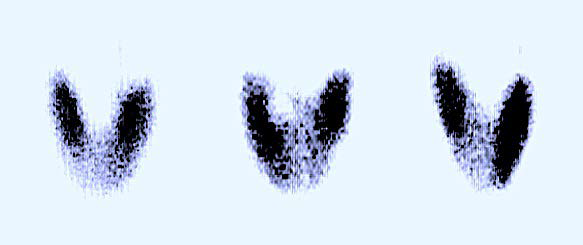A 41-year-old G2P1001 female patient was presented to the emergency department at 37-weeks of gestation with a prior history of non-compliance, uncontrolled hypertension and hyperthyroidism. Upon further questioning in the emergency department, the patient reported for a cesarean section (C-section) and bilateral salpingectomy for permanent sterilization and she was not taking her medications for her comorbid conditions. Diagnostic testing including assessment of thyroid stimulating hormone (TSH) and anti-thyroid peroxidase (anti-TPO) antibodies proved to be inconclusive due to high-levels of fluctuation. Further testing to confirm the degree of hyperthyroidism was then considered. A nuclear medicine thyroid uptake scan was performed after the risks and benefits were discussed with the patient. To reduce the risk for the fetus, the patient was advised to increase fluid intake. Increased fluid intake and increased urine output significantly reduces the risk of fetal exposure to radioactive material.1 Administration of 302 unique client identifier (UCI) of I-123 Isotope was administered and thyroid uptake was measured. Five-hours after administration, thyroid uptake was 63.8% and at 23-hours was 67.1%, both markedly increased. The normal uptake for these studies is 7-20% at 6-hours and 10-35% at 24-hours. As illustrated in Figure 1, the scan shows uniform isotope uptake evident of the right and left lobes of the thyroid gland with no focal areas of decreased or increased uptake. The radiologic impression significantly increased the isotope uptake at both 5-hours and 23-hours that is consistent with the graves disease. After the detailed discussion about the probable results with the patient, high-risk obstetric surgery was planned. A low transverse C-section was performed along with bilateral salpingectomy. The patient tolerated the procedure well with no anesthetic complications. Upon the birth of the neonate, there were no complications reported after assessment by an inhouse neonatologist. Thus, making this high-risk surgery a success. Graves disease affects 1 out of every 1000 women and the unique steps taken during this case has made it successful and noteworthy.2
Figure 1. Uniform Isotope Uptake Evident of the Right and Left Lobes of the Thyroid Gland with No Focal Areas of Decreased or Increased Uptake

DISCUSSION
It is important to note that the patient was documented as clinically euthyroid and short-term corticosteroids were given. Despite the patient’s history of hyperthyroidism disease, she had no reported complications during any previous pregnancies.3 Given the fact that poorly controlled thyrotoxicosis is related to several maternal and fetal complications, it is crucial to achieve euthyroidism rapidly. Short-term courses of corticosteroids should be considered to attain rapid clinical and biochemical control of thyrotoxicosis.4 Fluctuating levels of initial diagnostic testing led to consideration of nuclear medicine. In addition to reducing the risk for the fetus being exposed to radioactive material through aggressive hydration of the mother, many studies have suggested pregnant women do not undergo nuclear medicine procedures unless risks outweigh safety.1 Risk is considered fairly low when used for diagnostic purposes, as highlighted in this case. As fetal surveillance is highly paramount, the patient reported that she had been seeing an obstetrician regularly for prenatal care. Successful high-risk surgery was completed, and postpartum advice to not breastfeed after the surgery due to exposure of radiation was explained to the patient.
CONSENT
The authors have received written informed consent from the patient.
CONFLICTS OF INTEREST
The authors declare that they have no conflicts of interest.






